1 In 30 Million Orange Lobster Noticed in Delivery and Rescued By Restaurant Workers
A bright orange lobster arrived in a shipment at a Red Lobster restaurant in Hollywood, Florida, where it might have been cooked.

It's a common refrain to say we know more about the surface of Mars than we do about the deepest parts of our oceans, well a recent paper has shown that maxim extends to the creatures that live there in an embarrassing way.
Humanity has a half-dozen on Mars, but it took until 2022 for Sato's beaked whale to observed alive for the first time.
Beaked whales, the authors write, are the least-studied of their kind, owing to their low surface profile, long dives, lack of visible blow, general elusiveness, and preference of oceanic shelf or deep ocean habitat.
Sato's beaked whale has remained elusive for perhaps centuries. The Japanese whaling industry hunts its cousin, Baird's beaked whale, and the whalers have long been aware that there was a species abound in the same waters that was smaller and darker-skinned. For years it was called "Raven" in the Japanese language.
In 2019, Japanese researches confirmed scientifically its existence using DNA analysis from a deceased individual, but it was two years later when Russian scientists studying killer whales in the choppy waters between their nation and the island of Hokkaido that they found a pod of 14 of the elusive animals.
At 7 meters, or roughly 21 feet in length, it seems mad that they could remain unseen for so long, but of the 24 species of beaked whale theorized to exist, only 3 are reasonably well-researched.
The sighting was later confirmed by a biopsy performed via crossbow on one of the sighted individuals.
Hakai Magazine spoke with Erich Hoyt, a research fellow at Whale and Dolphin Conservation in the UK, who said it was some scars on their hide that gave the first clue as to the animal's behavior.
Hoyt, who coauthored the paper announcing the 2021 sighting, noted the bite marks of cookie-cutter sharks that suggested the whales could be either more widely dispersed or migratory. Cookie-cutter sharks are small fish that inhabit warm tropical waters and who leave a one-of-a-kind bite mark due to their unique jaw shape.
This is critical information since Sato's beaked whale has only ever been seen around Japan and Russia.
In 2020, the IUCN designated them as Near-Threatened.
SHARE This Secretive Whale With Your Friends…
Be the first to comment